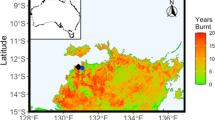Abstract
Over the past several thousand years, arid and semiarid China has experienced a series of asynchronous desertification events in its semiarid sandy and desert regions, but the precise identification of the driving forces of such events has remained elusive. In this paper we identify two rapid desertification events (RDEs) at ~4.6 ± 0.2 ka BP and ~3.3 ± 0.2 ka BP from the JJ Profile, located in the eastern Mu Us Sandy Lands. These RDEs appear to have occurred immediately following periods marked by persistently frequent and intense fires. We argue that such fire patterns, directly linked to an uncontrolled human use of vegetation as fuel, played a key role in accelerating RDEs by ensuring that the land surface was degraded beyond the threshold required for rapid desertification. This would suggest that the future use of a massive and sustained ecological program of vegetation rehabilitation should reduce the risk of destructive fire.
Similar content being viewed by others
Introduction
The arid and semiarid region of North China consists principally of sandy lands, deserts and loess deposits and lies at the junction of four principal atmospheric circulatory systems (Fig. 1A). Under global warming the risks of desertification and humidification in the sandy areas are carefully evaluated based on the parameters obtained from written records and observational data1,2 as well as longer time-series proxies of sedimentary materials (e.g., grain-size12,13 and human14 factors, or a combination of both1,11,15. However, the reduced precipitation resulting from a weakening Asian monsoon was thought to be the principal factor controlling green/sandy shifts in these areas12,21,26,27. However, the most recent results support the view that atmospheric change seem to occur contemporaneously and widely, meaning that any sediments extant under such an atmosphere can exhibit similar responses. For example, millennial-scale Younger Dryas and Heinrich events are well-recorded by coarser grain-sizes on the CLP, where such sediments were transported further and deposited by, the stronger winds resulting from a cooler drier climate4. This suggests that any Holocene dry events should also be contemporaneous with changes in sedimentary characteristics under the similar atmospheric dynamics28. Regardless of any nonlinear12,26,27 or linear relations34. Under such a scenario, the vegetation coverage and local environment may be significantly altered by “slash and burn” agricultural activity, rural construction and the use of fire for producing pottery, cooking and providing warmth34.
The Mu Us Sandy Lands and their neighboring regions have been intensively inhabited since at least the Last Glacial Maximum35. Human agriculture flourished during the Holocene, especiallyin cultural periods such as the Yangshao, Longshan, Zhukaigou and Maoqinggou (~9.0–2.0 ka BP)36,37,39. Over 400 ancient cultural sites dating to before 4.0 ka BP have been identified in the Mu Us Sandy Lands40. Additionally, several fire events appear to have occurred in the regions surrounding the Mu Us Sandy Lands, based on charcoal assemblages34 and total MC8,21 and black carbon content12. After superimposing human activity, under the same climatic process, the barren land surface caused by human activity can accelerate any risk that the RDE threshold is crossed (Fig. 4B). In the historic Mu Us Sandy Lands this finding is coincident with the data from many Neolithic and Bronze Age archeological sites in this region36,12. (B) After superimposing human activity, under a background of decreasing precipitation, we encounter the irreversible destruction of vegetation beyond the RDE threshold, when vegetation is used for fuel.
Today, the Mu Us Sandy Lands are an important agro-pastoral transition zone and a powerful ecologically-protective screen preventing the incursion of deserts from the south and east. According to this analysis, future major ecological rehabilitation should focus on improving vegetation coverage and avoiding fire hazards to reduce the risk of desertification. Once the vegetation has been seriously damaged, land degeneration will greatly increase the risk that the RDE threshold is crossed.




